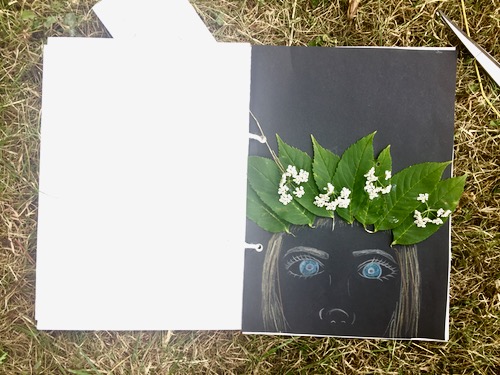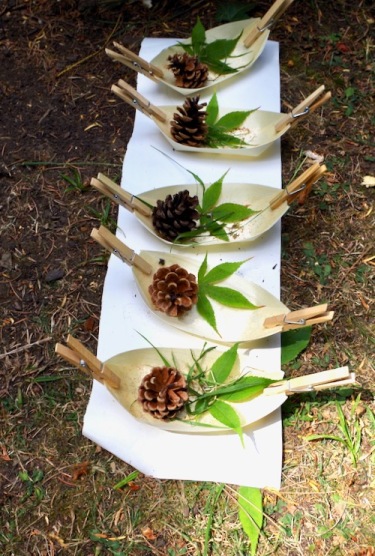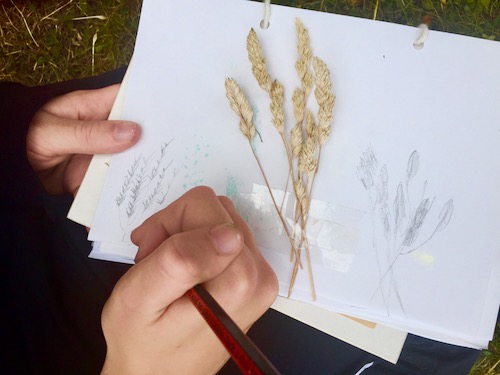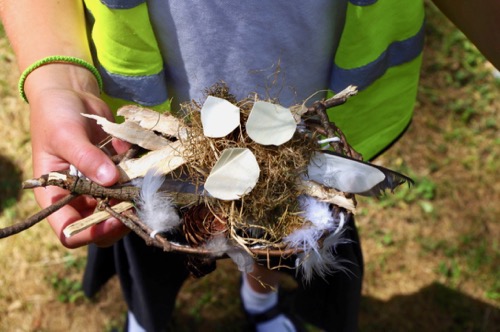A lot of my recent work with groups and organisations (including School Without Walls and Salisbury Cathedral Outreach) has focused on wellbeing. The wellbeing that comes from having your needs met as a creative individual, and applying your creativity to an exploration of where you live or work.
In the last few weeks I have supported different groups of children to pay attention to their local environment and what they notice about it. I have then provided ways of recording and responding to our ‘noticings’, framing the sessions with a suggestion that we bring our whole selves to our work – what our senses tell us about where we are, how a place makes us feel emotionally, and what it reminds us of.

One of the schools that I’ve been working with is a Thrive school. Students’ social and emotional wellbeing and development is gauged by a process that places them along a sliding scale from Being through Doing to Thinking.
‘In the Thrive Approach we use a developmental model to help us understand how we develop socially and emotionally from birth through to adulthood….The emotional regulation system in all of us is made up of three levels. These three levels are shaped in our early experience in our closest relationships. They are addressed within the Thrive model: Being, Doing and Thinking.’

My own son has been assessed in this way. Children whose early development was interrupted by traumatic events (neglect, abuse, bereavement etc) miss out on necessary nurturing experiences and the lack of a connected, reliable adult. These children may be said to be operating at the Being stage (0 to 6 months) and need input from teachers and carers that provide experiences of Being together. Led by the interests and ideas of the child, and supported by an attentive adult, this time helps to compensate (if only temporarily) for the gaps in their early development.
I can’t help but see parallels between the impact of an interrupted child to parent relationship, and the disconnect between our society and the ‘more than human’ world. The origins of the ecological and social crises that we face (and their impact on our wellbeing), lie in our collective inability to perceive a ourselves as connected to each other, and the other beings with whom we share our planet.

‘As part of a growing movement to shift the paradigm of a bounded, isolated self toward a vision of a self that is permeable, interconnected not only with other human selves but with all living beings and processes, a new theory of child development must be evolved. Such a theory must take into consideration that the infant is born not only into a social but an ecological context. It must acknowledge that, from the earliest moments of life, the infant has an awareness not only of human touch, but of the touch of breeze on her skin, variations in light and colour, temperature, texture and sound.’
Anita Barrows (The Ecopsychology of Child Development)
Are we at that ‘Being’ stage, in our relationship with plants, animals, rivers and oceans? Do we have gaps in our development that allow us to experience ourselves as separate, to do harm to the very systems that provide us with life? What do we need to enable each of us to grow up feeling ourselves to be connected with all that is?

At school my son’s Thrive action plan suggests that he spends time with his class’s Teaching Assistant. She follows his lead, lets him know he is seen and heard, responds to his suggestions. She notices him. He in turn feels safe enough to let down his defences, to allow the world in and to reach out in return, and make connections that allow him to learn.
The students (Pre-School, Primary and Secondary) that I’ve worked with over the last few weeks, have been taken out of their usual classes, often out of school itself, with its structures and assessment procedures (some necessary and useful, others not), and given a chance to begin to develop a relationship with their local environment. Some have found this challenging, without the familiar structure of school, and this has provided us with learning about how to provide for the needs of more vulnerable children. Once out and exploring together, we have asked them to respond to what they notice (what shows itself to them), and after a while to begin to notice how/what they notice, learning both about the place and themselves.

We walk together and record, by writing, printing or rubbings, drawing or collecting. We talk about what we find and feel, or make with clay to reflect and process with our minds and bodies. We map our experiences in ways that make sense to us and which plot and reflect on our journey.
‘In the wake of human history thus far, devastation and destruction point to a misconception about the ‘way of things’ or, as some might say, the ‘order of life’. Whatever the errors are, they are brutal to our inner worlds and the worlds of which we are a part. It may be that we are navigating with the wrong map…’
Nora Bateson (Small Arcs of Larger Circles)
As a society we need to provide our children and ourselves with more of these kinds of experiences; ways of knowing the world through relationship, through Being with plants and animals, rain and feathers, plastic packaging and pavements. We need to know the world as a whole, and ourselves as part of it, through our bodies and our creativity.

Each of us brings what we need into life, if we are only supported to experience and activate that, through relationship with the systems of which we are a part. When we feel held and seen, we feel safe and valued, and when we experience our potential through creative engagement with natural and social systems, we experience ourselves as an integral part of that system, with the responsibility that brings to act for the benefit of all.
‘Art does not ask for proof; it directs us to look for pattern….We are pulled from the illusion that we can watch life from our safe place at the window. We are participants in the process… ‘
‘…it is clear we have made some serious miscalculations over the last 100 years. All the proof in the world has not provided the information that we need to see the complexity of the world we live in. We do not understand it. We make decisions that unfold into wild and unforeseen consequences. The proof was not enough. We needed the pattern.’
Nora Bateson (Small Arcs of Larger Circles)
(Thank you to Dr. Steve Marshall for helping to prompt this post with his own – The Art of Reconnection)
Really interesting and sounds a fantastic project to help children thrive.
LikeLike
Thank you so much for your comment, I’m glad you think so
LikeLiked by 1 person
Powerful work and a beautiful post. I hope you get to do more in this field.
LikeLike
Thanks very much Ruth
LikeLike